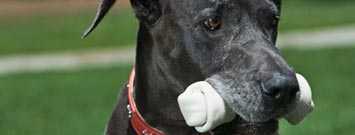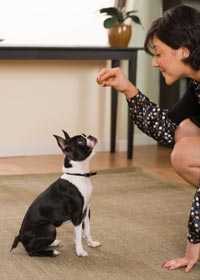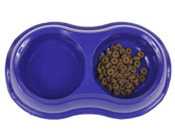Pet Food and Treats

Tips for Keeping People and Pets Healthy and Safe from Salmonella
A healthy diet is important for pets. But did you know that dry pet food, treats, and supplements can become contaminated with Salmonella, a harmful germ that can make both people and pets sick? To protect you and your pet from getting sick, it is important to know how to correctly purchase, handle, store, and behave when handling dry pet foods and treats.
Pets that eat contaminated food can carry germs even if they appear healthy. Salmonella germs can cause diarrhea in people, which can be mild, severe, or even life threatening. Children under 5 years old, adults aged 65 years and older, and people with weakened immune systems are at higher risk for severe illness. With the proper attention to what you choose to feed your pet and how you feed them, you could keep you and your pets healthy and safe from germs could be found in pet food.
Do not feed your pet a raw diet
Here is why:
- Raw diets consist of foods such as meat, poultry, milk, and eggs that have not been cooked or treated to remove harmful germs.
- These food items can carry harmful bacteria including Salmonella and Campylobacter.
Pet food can make pets and people sick
Pet ownership has many positive benefits. Pets comfort us and give us companionship. But as much as we love animals, there are simple precautions we need to take to keep our family members, including our four-legged members, safe and healthy. Here are some tips to help protect you and your family.
Shopping for your pet? Here are some purchasing tips:
- Look at the package:
- Buy bagged food with no visible signs of damage to the packaging, such as tears or discolorations.
- Avoid buying canned food with dents.
- Avoid raw diets for your pets:
- CDC recommends against feeding raw food to dogs and cats because of the risk of illness to the pet as well as to people living in the household.
Serving up a meal for your pet? Here are preparation tips:
-

Wash hands right after handling pet food and treats
- Washing your hands is the most important step to preventing illness.
- Wash your hands for 20 seconds with water and soap right after handling pet food and treats, and especially before preparing, serving or eating food, drinks or preparing baby bottles
- It is important to follow good kitchen hygiene practices when handling pet food, just as you would when you handle human food. When possible, feed your pet in areas other than the kitchen.
- Avoid washing your pet’s food and water dishes in the kitchen sink or bathtub in order to prevent cross-contamination.
- If there is no alternative, clean and disinfect the sink after washing pet food items. Infants should not be bathed in kitchen sinks because of the risk of cross-contamination.
- Do not use the pet’s feeding bowl as a scooping utensil – use a clean, dedicated scoop, spoon, or cup.
Storing pet food and treats? Here are storage tips:
- When possible, store pet food away from any area where human food is stored or prepared.
- If possible, store dry pet food in its original bag inside a clean, dedicated plastic container with a lid, keeping the top of the bag folded or closed.
- Store dry pet food and pet treats in a cool, dry place under 80 degrees F.
- Promptly refrigerate or discard unused, leftover wet pet food and containers (e.g., cans, pouches).
- Refrigerating foods quickly prevents the growth of most harmful bacteria. Refrigerators should be set at 40 degrees F. The accuracy of the setting should be checked occasionally with a refrigerator thermometer.

Feeding your pet? Here are feeding tips:
- When possible, avoid feeding your pet in the kitchen to prevent getting germs found in pet food on “people” food.
- Keep children 5 years and younger away from areas where pets are fed to help prevent illness and injury.
- Wash your hands right after feeding your pets.
Follow these simple guidelines to prevent getting a Salmonella infection from your pet:
- Wash your hands well with soap and running water right after contact with animals, their food, or their environments.
- Clean up after your pet.
- For dogs, pick up waste and discard it into a tightly sealed plastic bag.
- For cats, scoop litter daily and discard waste into a tightly sealed plastic bag.
- Place all waste into a closed trash can.
Salmonella outbreaks are not just linked to “people food”. Pet food and pet treats have been associated with outbreaks and illnesses in people and pets. For more information see Selected Reports for Salmonella Outbreaks Linked to Pet Food and Treats (below).
- Pet waste can contain bacteria, so young children should not clean up after pets.
- Remember to wash your hands right afterwards!
Children and pets:
- Young children are especially at risk for illness because their immune systems are still developing and because they are more likely than others to put their fingers or other items into their mouths.
- Children younger than 5 years of age should not be allowed to touch or eat pet food, treats, or supplements and should be kept away from pet feeding areas to prevent illness and injury.
- Adults should supervise young children when washing hands.
More Information
For Consumers
- Poster: Pet Food and Salmonella
- Gastrointestinal (Enteric) Diseases from Animals
- FDA Animal & Veterinary: Recalls & Withdrawals
- CDC’s Healthy Pets Healthy People
- CDC Kidtastics Podcast: Wash Your Hands [PODCAST – 0:51 minutes]
- CDC Radio: Hand Washing PSA
- Salmonellosis
- Tips to Reduce Your Risk of Getting a Salmonella Infection from Dry Pet Food [PODCAST – 2:56 minutes]
- Dog Bite Prevention
- How do I know if my dog or cat has Salmonella infection?
- How are Salmonella infections diagnosed and treated in dogs, cats, and other animals?
- What can I do to prevent the spread of Salmonella germs from my pets?
For Veterinarians and Public Health Professionals
- FDA Animal & Veterinary: Recalls & Withdrawals
- What is the clinical presentation of salmonellosis in dogs and cats?
- To whom do I report a suspected or confirmed Salmonella illness in an animal?
- I’ve already submitted a complaint to FDA, when will I get a response?
- What type of samples should I collect from an animal with suspected Salmonella infection and a history of exposure to a recalled pet food? What laboratory should I send the sample to for testing?
- American Veterinary Medical Association: Dog Bite Prevention
- CDC’s Healthy Pets Healthy People
- Salmonellosis
Selected Reports for Salmonella Outbreaks Linked to Pet Food and Treats
- Multistate Outbreak of Human Salmonella Infantis Infections Linked to Dry Dog Food
- Notes from the Field: Human Salmonella Infantis Infections Linked to Dry Dog Food — United States and Canada, 2012. MMWR Weekly, June 15, 2012 / 61(23);436-436.
- Multistate Outbreak of Human Salmonella Infections Caused by Contaminated Dry Dog Food — United States, 2006–2007
- Update: Recall of Dry Dog and Cat Food Products Associated with Human Salmonella Schwarzengrund Infections — United States, 2008
- Human Salmonellosis Associated with Animal Derived Pet Treats—United States and Canada, 2005
- Page last reviewed: September 3, 2013
- Page last updated: September 3, 2013
- Content source:
- National Center for Emerging and Zoonotic Infectious Diseases, Division of Foodborne, Waterborne, and Environmental Diseases
- Page maintained by: Office of the Associate Director for Communication, Digital Media Branch, Division of Public Affairs




 ShareCompartir
ShareCompartir